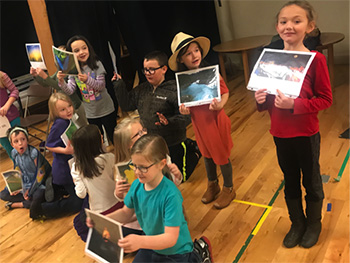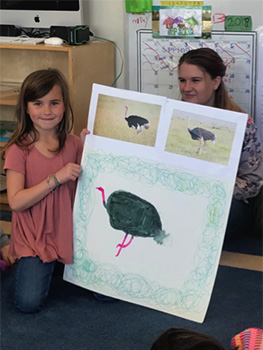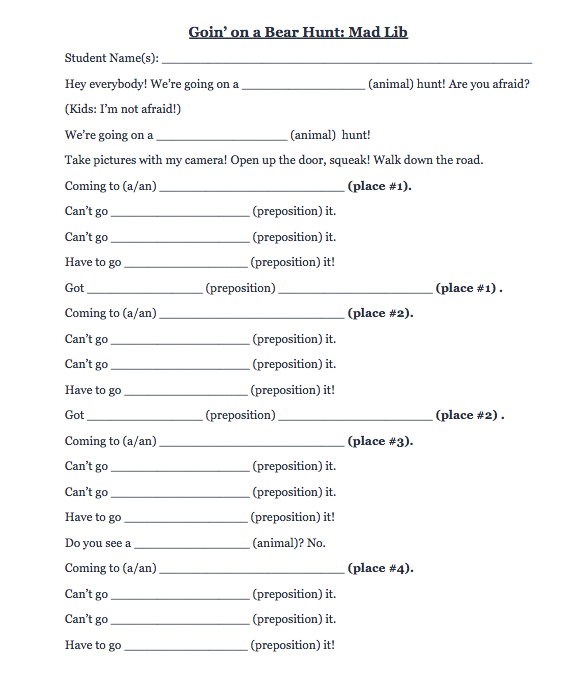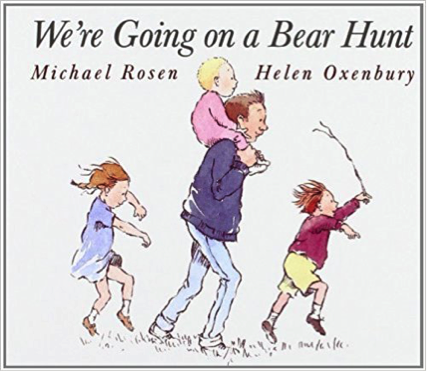SUBJECTS
GRADE
Show Results
Goin' on a Bear Hunt

Lesson Summary
- Write an original version of "We're Going on a Bear Hunt" by adding new prepositions, nouns, and verbs to a Mad Libs template.
- Perform the story through a call-and-response with the class.
Lesson Plan and Procedure
Lesson Key Facts
- Grade(s): 2, 3
- Subject(s): Drama, English Language Arts, Science
- Duration of lesson: 50 minutes
- Author(s): Haley Flanders Anderson
*Note: Prepare your students by introducing them to Mad Libs. Review the grammar functions of prepositions, nouns, and verbs. It is helpful to introduce animal habitats as well.
Warm-Up/Hook
Gather the students in a circle on the floor.
Teacher: We have been talking about animals’ habitats. Can you think of some habitats that animals live in (e.g., forest, water, desert, or rainforest)? Habitats provide the basic needs or resources that animals need to survive.
Ask students to think about and share what the basic needs of animals are.
Teacher: Where do the American black and grizzly bears live? They usually live in the forest and make their shelter or home in caves. Today we are going to listen to “Goin’ on a Bear Hunt” to find the bear in its habitat. We will travel through other habitats to find it. This is a call-and-response story, which means that every time the man says a line, you will repeat it back to him with the children on the track. Follow my actions.
Play the track “Goin’ on a Bear Hunt” by Greg and Steve, and repeat the lyrics with the students. Perform the actions with the accompanying lyrics, and have the students copy you. The lyrics and accompanying actions sheet can be found below, in the equipment and materials section.
For the remainder of the song, repeat the motions faster and in the opposite order. Anytime the man says to run, remind the students to pat their hands on their laps or knees. Remind the students to stay seated.
You can also use images for each location or image in the song (e.g., camera, door, road, wheat field, bridge, tree, river/boat, cave, bear). You can have the students either flip them in a binder as they are mentioned or hold them up, if they would rather do that than perform the actions.
Reflection
Teacher: What habitats did we visit in the song? What animals might live in each of the environments we visited? What basic need does the cave meet for the bear? (Shelter.) What other animals might share the bear’s habitat? How is their basic need for shelter met?
Introduction
Teacher: Let’s talk about some important words in the story and what kind of words they are. Can someone remind me what three options we have for a noun? A person, place, or thing. Every place we went was a noun. And the bear and the people on the hunt were also nouns. Every time we arrived at a new location, what did we have the figure out? We determined how to get by, what to do next so we could reach our new location. We had to figure out the right preposition to go over, under, up, down, through, and so on. We even had some verbs in our story, which gave us actions like tip-toeing, running, rowing, climbing, opening the door, and closing it.
You and a partner are going to write your own story, just like the song. You will fill out a Mad Lib, which means that it will have blanks for you to fill out. It will say, in parentheses, if a noun, preposition, or verb is needed.
Give the students the following directions:
- Decide what animal you are hunting and where that animal lives in nature.
- Choose other places you will visit on you way to find the animal.
- Determine the wrong and right prepositions to get past the places you have chosen.
- Once you find your animal, you will repeat the places backwards and write down verbs between each place as you run back home.
- Draw a picture of your animal in its habitat. Include some of the ways the habitat meets your animal's basic needs. Be as creative as you like.
- When you are finished, you will show you drawing and read the Mad Lib to the class, who will act as your echo in the call-and-response part.
Instruction/Rehearsal
Put your class into pairs or groups of three. Show the class all three papers as you introduce them. Each pair/group will have a copy of the lyrics from the track, a Mad Lib, and a paper to draw their animal. Take any questions. Provide examples verbally for various parts of the Mad Lib, if necessary. Give the groups time to write and draw. Provide resources for animals and their habitats, as well as sample lists of nouns, prepositions, and verbs, if needed. Encourage the students to rehearse the Mad Lib aloud. If students choose to act out portions of their Mad Lib, instruct them to create actions that can be done from a seated position, since the whole class will participate in the call-and-response part.
Teacher: As you write, draw, and rehearse, focus on descriptive words and actions. Engage our senses and imaginations. Do not make the Mad Lib too complicated or silly. Be creative but follow the template outline, and make sure the Mad Lib makes sense. Think about where we might look for this animal if we did not know its habitat. Be appropriate with your word choices.
 Activity/Performance
Activity/Performance
Invite the class to gather, and have each group perform. It is best to number the groups beforehand, so transitions run smoothly. Each group will read their template in unison, or one person can read it while the other(s) show(s) the picture. Remind students about the importance of being a respectful audience. Have the rest of the class simply repeat the lines with the group in call-and-response, rather than acting them out, since some groups might have chosen verbs that are difficult or distracting to perform inside.
Conclusion
Teacher: Let’s review the grammar that was missing from our Mad Libs. Raise your hand and give me an example of a noun. Give me an example of a preposition. Give me an example of a verb. Now give me an example of an animal and its habitat. Why do you think this is the animal’s habitat? What are the resources the animal needs to survive, and how does it receive them from this particular environment? Why do animals live in different habitats?
Photocopy their templates and pictures so that each child has a copy. Perhaps make another copy to create a class book of the Mad Libs.
Possible extension activities
- Read the book We're Going on a Bear Hunt, written by Michael Rosen and illustrated by Helen Oxenbury. Have the students act it out, draw pictures from it, or create their own Mad Lib from it. Michael Rosen performs the book in this delightful YouTube video: https://www.youtube.com/watch?v=0gyI6ykDwds
- Play an animal-habitat sorting game.
- Brainstorm nouns, prepositions, and verbs to put on your classroom's word wall.
Learning Objectives
- Describe how text supplies rhythm and meaning in a story/song.
- Read orally with appropriate expression and accuracy.
- Demonstrate understanding of English grammar when writing and speaking.
- Compare living things in different habitats.
- Identify basic needs of living things and abilities to meet those needs.
- Develop imagination.
- Define roles and work in a group.
- Communicate character through physicality and voice.
- Identify elements of dramatic structure.
- Perform for classmates or another audience.
Utah State Board of Education Standards
This lesson can be used to meet standards in many grades and subject areas. We will highlight one grade’s standards to give an example of application.
Grade 2 English Language Arts
- Standard 2.R.4: Read grade-level text* with accuracy and fluency to support comprehension. (RL & RI)
- Standard 2.SL.3: Use age-appropriate language, grammar, volume, and clear pronunciation when speaking or presenting.
Grade 2 Science with Engineering Education (SEEd)
- Standard 2.2.1: Obtain, evaluate, and communicate information about patterns of living things (plants and animals, including humans) in different habitats. Emphasize the diversity of living things in land and water habitats. Examples of patterns in habitats could include descriptions of temperature or precipitation and the types of plants and animals found in land habitats. (LS2.C, LS4.C, LS4.D)
Grade 2 Drama
- Standard 2.T.CR.4: Define roles and responsibilities and participate in group decision making.
- Standard 2.T.CR.5: Create character through physical movement, gesture, sound and/or speech and facial expression.
- Standard 2.T.P.1: Identify the character, setting, and essential events (plot) in a story that make up the dramatic structure, and use choices to shape believable and sustainable drama/theatre work.
- Standard 2.T.P.2: Demonstrate the ability to work effectively alone and cooperatively, with a partner or in an ensemble.
- Standard 2.T.P.4: Use body to communicate meaning through space, shape, energy, and gesture.
- Standard 2.T.P.9: Share dramatic play and guided drama experiences within the classroom or with invited guests.
Equipment and Materials Needed
- Music track: “Goin’ On a Bear Hunt” by Greg and Steve (2000)
- Lyrics and action sheet, (one per group)
- Mad Libs template and drawing sheet (one per group)
- Pencils
- Materials for drawing and coloring
- Resources for researching animals and their habitats (optional)
- List of nouns, prepositions, and verbs (optional)
- Images to hold up during the track (optional)
Additional Resources
- Greg and Steve track of “Goin’ on a Bear Hunt”: https://www.youtube.com/watch?v=WzIcu6tbEko&t=18s
- Greg and Steve Kids in Action (2000) album that contains the song (track 4): https://www.amazon.com/Kids-Action-Greg-Steve/dp/B0000A8XP8
- We’re Going on a Bear Hunt, written by Michael Rosen and illustrated by Helen Oxenbury, pub. 1989 (ISBN: 0673805344): https://www.amazon.com/Were-Going-Bear-Michael-Rosen/dp/0689504764/ref=tmm_hrd_swatch_0?_encoding=UTF8&qid=1532389567&sr=8-1
- A link to the lyrics (they are also in the packet for this activity): https://kteachers.wordpress.com/songs-and-fingerplays/going-on-a-bear-hunt/
Video of Greg and Steve performing the song at the NAEYC 2013 conference: https://www.youtube.com/watch?v=KI5sttsGiDw
A website for researching animals and their habitats: https://kids.nationalgeographic.com/animals/
Image References
Images 1-4: Haley Flanders Anderson.

www.education.byu.edu/arts/lessons
 Download
Download
